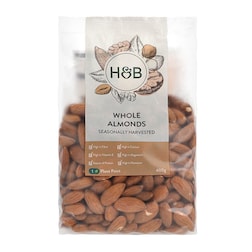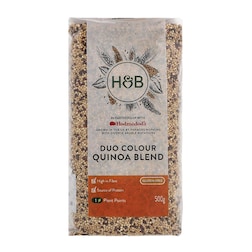15% off €25
Code:BASKET
10 high-fibre foods for a gluten-free diet

Hitting your daily fibre intake on a gluten-free diet doesn’t have to be hard. Say goodbye to gluten and hello to these ten high-fibre gluten-free foods
Our top picks
Packed with fibre and protein
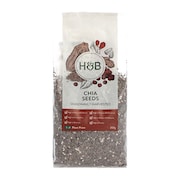
Holland & Barrett
Holland & Barrett Chia Seeds 200g
Buy 1 Get 1 Free
€3.99
Convenient source of fibre
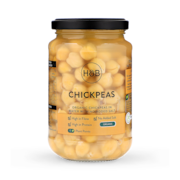
Holland & Barrett
Holland & Barrett Chickpeas 340g
€2.35
Sweet, crunchy and 100% apple
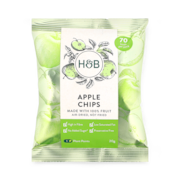
Holland & Barrett
Holland & Barrett Apple Chips 20g
Buy one get one 1/2 price
€1.69
Navigating a gluten-free diet can feel like a balancing act – making sure you’re avoiding gluten while still getting all the essential nutrients you need. And, when it comes to fibre, that balance can feel even more tricky.
Fibre is a complex group of indigestible substances found in fruits, vegetables, wholegrain cereals and pulses like beans. We need it to keep our digestive system moving, regulate our blood sugar and to create a healthy gut microbiome for a happy stomach.
But even though we really need dietary fibre, it’s thought that most adults only eat around 20g a day, when we should be eating 30g.1 And, getting your daily 30g of fibre on a gluten-free diet can be even more fiddly, thanks to the exclusion of foods like wholegrains (which are high in fibre!).2
Luckily, there are plenty of delicious gluten-free options which are good fibre sources that will help you maintain a happy gut, without compromising the needs of your diet.
10 high-fibre gluten-free foods
Potatoes
Good news for carb lovers - the humble, yet versatile potato, is gloriously gluten-free and packed with fibre too.3
One 200g jacket potato can provide up to 6.7g, which, when paired with a fibre-full topping like beans, can really make an impact on your fibre intake.4 Just make sure to eat the potato skin, as this is where the most fibre can be found.1 Sweet potatoes can be high in fibre too, with a 200g sweet potato containing around 6g.5 But again, try to eat the skin to make the most of the fibre it has to offer.
Even though potatoes may be naturally gluten-free, always check the labels of processed options, like crisps or chips, as they may contain traces of gluten.
Chia seeds
Chia seeds might be small, but don’t be fooled - they pack a real punch when it comes to their nutritional profile.
These tiny seeds are an excellent source of fibre, offering around 10g per 28g serving.6 They’re also packed with omega-3 fatty acids, protein and thanks to their gel-like quality, chia seeds expand in your stomach keeping you feeling fuller.7,8
Why not sprinkle chia seeds into your morning smoothie, on top of a yoghurt or try a chia pudding for a delicious gluten-free breakfast filled with fibre? If they’re not your thing, other seeds like flax seeds and sunflower seeds, contain lots of fibre too.
Brussels sprouts
Love them or hate them, sprouts are a great source of fibre and naturally gluten-free that can make up part of a varied healthy, balanced diet all year round, not just at Christmas.
Brussel sprouts are cruciferous vegetables and, while they may not have the best reputation, these types of veggies are full of fibre. One 80g serving (about eight sprouts), contains approximately 2g of fibre, plus that’ll count as one of your five-a-day.9
Sprouts can be so much more exciting than you think. Gone are the days of sad, boiled sprouts abandoned on your plate after your festive feast - we’re shredding them into salads, roasting them with chestnuts or sautéing them with pancetta to create truly mouth-watering side dishes.
But too many cruciferous vegetables can leave your stomach in knots, think tummy troubles, cramps and even gas10,11 it’s best to stick to eating them in moderation and gradually introduce them to your diet over time.
Almonds
If you’re looking for an easy, gluten-free snack, that fills up your fibre, almonds are a great choice.
Nuts like almonds offer a really simple way to add more naturally gluten-free sources of fibre to your diet – just one handful (around 30g) can add an extra 3g of fibre to your day.1 Try to pick plain almonds where you can and, if not, be sure to check the labels of the almonds you choose and watch out for traces of gluten, too much salt or added sugars.
If you want to satisfy your sweet tooth and jazz up your almonds, try melting some gluten-free dark chocolate and drizzling it over, or even sprinkling them with gluten-free cocoa powder to enjoy as a delicious, sweet treat.
Chickpeas
Chickpeas, or garbanzo beans, are a legume (the fruit of a plant in the pea or bean family) and are excellent sources of nutrients like fibre, plant protein, iron and folate.12,13
Just one portion of chickpeas, (defined by the NHS as three heaped tablespoons or about 45g) contains around 2.5g of fibre and 3g of protein.13,14
So don’t let their bland appearance fool you, there’s a reason that chickpeas have been loved for centuries – as far back as 10,000 years in fact!15 Why not sprinkle a serving of chickpeas on your lunchtime salad, make your own creamy hummus or roast them in the oven for a crunchy snack?
Beans
Like chickpeas, beans are also part of the legume family and are a really valuable source of fibre, naturally gluten-free. Whether mixed into a delicious dish or served on the side, beans like adzuki, broad, black, navy, kidney and even peas are fibre-filled additions to a healthy, balanced gluten-free diet.
With a low glycaemic index and high fibre content of 7.3g per 100g of beans, adzuki beans are a great addition to many meals like curries, burrito bowls and more.16 Broad beans, also known as fava beans, are packed with fibre too, offering around 7.6g per 100g serving, and the unassuming green pea packs an impressive 5.95g per 100g.17,18
Beans also make a delicious gluten-free snack in so many formats, but if you’re gluten-intolerant, look out for labels on processed bean snacks as they can often contain wheat flour.
Gluten-free grains
While grains like wheat, barley and rye all contain gluten and are a no-go for those on a gluten-free diet, other grains like quinoa, brown rice and buckwheat don’t.19,20
Popcorn is another deliciously gluten-free wholegrain, that is often naturally high in fibre. Whilst the exact amount of fibre varies depending on the type of popcorn and how it’s been prepared, a typical 20g serving of plain, air-popped popcorn contains around 3g of fibre.24
Just make sure to double check the packaging of your chosen grains to ensure they’re processed in a dedicated gluten-free environment.
Lentils
Another little legume, lentils are a surprising source of many nutrients. They might not look like much, but they’re actually packed with important nutrients like protein and folate.25 They’re a worthwhile addition to any balanced diet, but it’s their fibre content that makes them truly stand out.
Lentils offer around 8g of fibre per 100g serving, that’s over a quarter of the recommended daily fibre amount.26
They’re super versatile and easy to cook (just boil in some water for a few minutes), they make a great addition to soups, stews, sides, salads and so much more. Plus, you can find them in snack form too, from lentil crisps to crackers, cakes and more – but check the labels to make sure they don’t contain gluten.
Apples
We all know the saying, “an apple a day keeps the doctor away”. And, while it might not be a proven fact that eating an apple every day means less trips to your GP, it’s still a great way to up your fibre intake.27
On average, one granny smith apple can contain up to 2.5g of fibre, which might not sound like much, but that 2.5g can go a long way to getting you to your 30g goal.28
Other fruits like pears, bananas and oranges, can also contribute to your fibre intake. Pears, with the skin, can contain an impressive 5-6g of fibre, whilst medium-sized bananas and oranges provide about 2g each.29,30,31
If you don’t fancy crunching on a whole apple, dried apple makes a great snack too.
Avocados
Spread over toast, added to salads or whipped into a dip, avocados are loved for their healthy fat content, but what we often overlook is their fibre.
One 100g serving (roughly half a medium avocado) can provide around 6.7g of fibre – that’s more than 20% of your daily fibre goal.32
Like apples, there are different types of avocados, so the fibre content will vary dependent on the type you choose. And, while avocados are naturally gluten-free, be sure to double check the ingredients of any pre-processed avocado products, like guacamole.
Easy tips to increase your fibre intake
- eat your five-a-day: try to include at least five portions of fruit and vegetables every day
- bulk up with beans and pulses: add peas, beans or lentils to your meals for a fibre boost
- go for gluten-free wholegrains: try out gluten-free grains like quinoa or buckwheat
- choose complex carbohydrates: add gluten-free unrefined carbohydrates like potatoes and brown rice to your meals
- fill up on fibre-packed snacks: crunch on fruits, nuts or seeds to keep you feeling full
- don’t forget the skin: try to always eat the skin of your veggies, especially potatoes as this is where the most fibre is
The final say
Getting enough fibre is such an important part of a varied, healthy, balanced diet and cutting out gluten from your diet doesn’t have to mean saying goodbye to fibre too. There are so many foods that are both high in fibre and naturally gluten-free – from crunchy fruits and veggies to little legumes and even some types of grains.
If you’ve cut out gluten and are concerned you might not be eating enough fibre, have a chat with your GP or a registered dietician – they’ll be able to give you tailored advice on getting your fibre intake up safely.
This article provides informational advice and is not a substitute for medical care. Curated by experts for accuracy, we take great care to ensure the information is up-to-date and relevant. However, you should always consult your GP or healthcare professional before using supplements or alternative products, particularly if you have medical conditions or are under supervision.
1. NHS website. How to get more fibre into your diet [Internet]. nhs.uk. 2022 [cited 2025 Apr 4]. Available from: https://www.nhs.uk/live-well/eat-well/digestive-health/how-to-get-more-fibre-into-your-diet/
2. Giorgia Vici, Belli L, Biondi M, Polzonetti V. Gluten free diet and nutrient deficiencies: A review. Clinical Nutrition [Internet]. 2016 May 8 [cited 2025 Apr 1];35(6):1236–41. Available from: https://pubmed.ncbi.nlm.nih.gov/27211234/
3. King JC, Slavin JL. White Potatoes, Human Health, and Dietary Guidance. Advances in Nutrition [Internet]. 2013 May 1 [cited 2025 Apr 1];4(3):393S401S. Available from: https://pubmed.ncbi.nlm.nih.gov/23674809/
4. Fibre [Internet]. Coeliac UK. 2024 [cited 2025 Apr 1]. Available from: https://www.coeliac.org.uk/information-and-support/your-gluten-free-hub/home-of-gluten-free-recipes/healthy-eating/fibre/
5. USDA. Sweet potato, cooked, baked in skin, flesh, with salt [cited 2025 Mar 26]. Available from: https://fdc.nal.usda.gov/food-details/170134/nutrients
6. USDA. Chia seeds, dry, raw [cited 2025 Mar 26]. Available from: https://fdc.nal.usda.gov/food-details/2710819/nutrients
7. Ullah R, Nadeem M, Khalique A, Imran M, Mehmood S, Javid A, et al. Nutritional and therapeutic perspectives of Chia (Salvia hispanica L.): a review. Journal of Food Science and Technology [Internet]. 2015 Oct 1 [cited 2025 Mar 26];53(4):1750–8. Available from: https://pmc.ncbi.nlm.nih.gov/articles/PMC4926888/
8. Karimi M, Pirzad S, Shirsalimi N, Ahmadizad S, Hashemi SM, Karami S, et al. Effects of chia seed (Salvia hispanica L.) supplementation on cardiometabolic health in overweight subjects: a systematic review and meta-analysis of RCTs. Nutrition & Metabolism [Internet]. 2024 Sep 16 [cited 2025 Mar 26];21(1). Available from: https://nutritionandmetabolism.biomedcentral.com/articles/10.1186/s12986-024-00847-3
9. USDA. Brussels sprouts, cooked, boiled, drained, without salt [cited 2025 Mar 26]. Available from: https://fdc.nal.usda.gov/food-details/169971/nutrients
10. NHS website. Bloating [Internet]. nhs.uk. 2022 [cited 2025 Apr 14]. Available from: https://www.nhs.uk/conditions/bloating/
11. Eating, Diet, & Nutrition for Gas in the Digestive Tract [Internet]. National Institute of Diabetes and Digestive and Kidney Diseases. NIDDK; 2025 [cited 2025 Apr 14]. Available from: https://www.niddk.nih.gov/health-information/digestive-diseases/gas-digestive-tract/eating-diet-nutrition
12. Legume | Definition & Examples [Internet]. Encyclopedia Britannica. 1998 [cited 2025 Apr 23]. Available from: https://www.britannica.com/science/legume
13. USDA. Chickpeas (garbanzo beans, bengal gram), canned, sodium added, drained and rinsed [cited 2025 Mar 26]. Available from: https://fdc.nal.usda.gov/food-details/2644288/nutrients
14. NHS website. 5 A Day portion sizes [Internet]. nhs.uk. 2022 [cited 2025 Apr 1]. Available from: https://www.nhs.uk/live-well/eat-well/5-a-day/portion-sizes/
15. Lucas L, Fuller DQ. Chickpea: Origins and Development. Encyclopedia of Global Archaeology [Internet]. 2014 [cited 2025 Apr 23];1384–7. Available from: https://link.springer.com/referenceworkentry/10.1007/978-1-4419-0465-2_2324
16. USDA. Beans, adzuki, mature seeds, cooked, boiled, without salt [cited 2025 Mar 26]. Available from: https://fdc.nal.usda.gov/food-details/173728/nutrients
17. USDA. Broad beans (fava beans), mature seeds, cooked, boiled, without salt [cited 2025 Mar 26]. Available from: https://fdc.nal.usda.gov/food-details/173753/nutrients
18. USDA. Peas, green, sweet, canned, sodium added, sugar added, drained and rinsed [cited 2025 Mar 26]. Available from: https://fdc.nal.usda.gov/food-details/2644291/nutrients
19. Rai S, Kaur A, Chopra CS. Gluten-Free Products for Celiac Susceptible People. Frontiers in Nutrition [Internet]. 2018 Dec 17 [cited 2025 Apr 1];5. Available from: https://pubmed.ncbi.nlm.nih.gov/30619866/
20. Melini V, Melini F. Functional Components and Anti-Nutritional Factors in Gluten-Free Grains: A Focus on Quinoa Seeds. Foods [Internet]. 2021 Feb 7 [cited 2025 Apr 1];10(2):351–1. Available from: https://pubmed.ncbi.nlm.nih.gov/33562277/
21. USDA. Quinoa, cooked [cited 2025 Mar 26]. Available from: https://fdc.nal.usda.gov/food-details/168917/nutrients
22. USDA. Rice, brown, medium-grain, cooked (Includes foods for USDA's Food Distribution Program) [cited 2025 Mar 26]. Available from: https://fdc.nal.usda.gov/food-details/168875/nutrients
23. USDA. Buckwheat, whole grain [cited 2025 Mar 26]. Available from: https://fdc.nal.usda.gov/food-details/2512378/nutrients
24. FoodData Central [Internet]. Usda.gov. 2024 [cited 2024 Oct 23]. Available from: https://fdc.nal.usda.gov/fdc-app.html#/food-details/167959/nutrients
25. Alexander R, Khaja A, Debiec N, Fazioli A, Torrance M, Razzaque MS. Health-promoting benefits of lentils: Anti-inflammatory and anti-microbial effects. Current Research in Physiology [Internet]. 2024 Jan 1 [cited 2025 Apr 9];7:100124–4. Available from: https://pubmed.ncbi.nlm.nih.gov/38501131/
26. USDA. Lentils, mature seeds, cooked, boiled, without salt [cited 2025 Mar 26]. Available from: https://fdc.nal.usda.gov/food-details/172421/nutrients
27. Davis MA, Bynum JPW, Sirovich BE. Association Between Apple Consumption and Physician Visits. JAMA Internal Medicine [Internet]. 2015 May 1 [cited 2025 Apr 9];175(5):777. Available from: https://pmc.ncbi.nlm.nih.gov/articles/PMC4420713/
28. USDA. Apples, granny smith, with skin, raw [cited 2025 Mar 26]. Available from: https://fdc.nal.usda.gov/food-details/1750342/nutrients
29. USDA. Pears, raw [cited 2025 Mar 26]. Available from: https://fdc.nal.usda.gov/food-details/169118/nutrients
30. USDA. Bananas, raw [cited 2025 Mar 26]. Available from: https://fdc.nal.usda.gov/food-details/173944/nutrients
31. USDA. Oranges, raw, Florida [cited 2025 Mar 26]. Available from: https://fdc.nal.usda.gov/food-details/169918/nutrients
32. Avocado 100g [Internet]. Nutritionix.com. 2025 [cited 2025 Apr 14]. Available from: https://www.nutritionix.com/food/avocado/100-g


